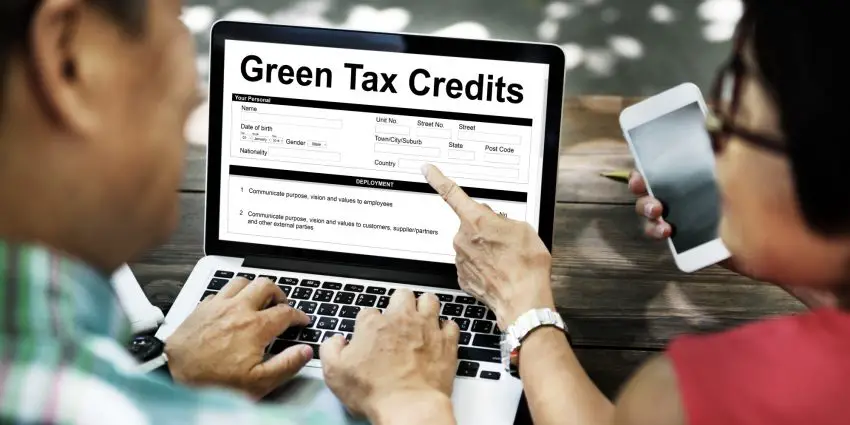The Solar Tax Credit 2022 is a valuable incentive that can help reduce the cost of solar energy systems.
According to the Solar Energy Industries Association, solar has seen 42% annual solar growth as a result of the Solar Investment Tax Credit (ITC).
To qualify for the solar tax credit, certain requirements must be met. In this blog post, we will provide an overview of the solar tax credit and what you need to know to take advantage of this incentive.
Here at Tax Savers Online, we’re experts on business, finance, and taxes so we’re ready to give you all the details on Section 25D of the Internal Revenue Code.

Contents
What is Solar Tax Credit?
Solar Tax Credit is a term used to describe the Federal solar tax credit, which is also known as Section 25D of the Internal Revenue Code.
This solar tax credit allows taxpayers who install solar energy systems in their homes and businesses to receive a tax credit for 26% of the cost of the system.
Projects which begin construction in 2023 will see a tax credit drop to 22% as the project is slowly phased out.
It was intended to encourage solar energy adoption by helping solar panel owners pay for the costs of solar.
The solar tax credit has been around since 2006, but it was set to expire at the end of 2019 and has been extended multiple times. Most recently it has been extended for both residential and commercial use until 2023.
Presently, only commercial extensions are cleared for 2024.
How Does This Tax Credit Work?
The solar investment tax credit is a dollar-for-dollar reduction in the amount of taxes you owe. The solar energy systems that qualify for a 26% tax credit must be placed into service by December 31, 2022.
If you use solar to heat your home or water heater instead of using electricity and gas, then you can claim 26 percent of the solar system as a tax credit on your taxes. If you use solar to generate electricity, then you can claim 22 percent of the solar system as a tax credit on your taxes.
The solar ITC is 26% percent of the cost of installing a solar energy system, including labor costs and other expenses related to installation, and electricity generated.
Time is running out because the initiative is set to end in the next couple of years.
Solar Investment Tax Credit Extension in 2022
Starting in 2022, solar tax credits will be phased out over the next three years until they are gone entirely. So what does that mean for you?
In 2022 the tax credit fell from 30% to 26%, then in 2023 it will fall again to 22% and finally, in 2024 it will drop to 0% for residential use and 10% for commercial use.
Can You Qualify for the Solar Tax Credit 2022?
You can read an overview of how to qualify for the tax credit as a commercial business, on the Solar Industries Association website. They explain that the IRS has released guidance on the requirements for taxpayers running commercial enterprises to qualify for the solar tax credit.
Simplified guidelines for homeowners are available on the energy.gov website too.
To summarize, homeowners may be eligible for this tax credit if they fulfill all of the following conditions:
- Between January 1, 2006, and December 31, 2023, your photovoltaic system was put in place
- In the United States, your primary or secondary residence is where you install a solar PV system
- You are the owner of the solar PV system (there’s now no rental eligibility)
- The solar PV installation is either brand new or has never been used before, so it’s an ‘original installation’
The following charges are covered by this plan:
- The photovoltaic solar panels or PV cells (but not the fan they power)
- Costs of labor for onsite preparation, installation, or original construction, including permit fees, inspection expenditures, and developer expenses
- Purchase of required electrical equipment, including wiring, inverters, and mounting equipment
- Battery banks (and other energy storage devices) that are charged only by the connected solar PV panels
The solar tax credit is available for a limited time and there are currently no plans to extend it again for residential purposes past 2023. Now is the time to apply!
Solar Renewable Energy Certificates (SRECs)
Solar renewable energy certificates (SRECs) are a performance-based solar incentive that enables you to profit from solar power generation. An SREC is earned for every megawatt-hour (MWh) or 1,000 kilowatt-hours (kWhs) of electricity your solar panel system creates as a homeowner.
Have you heard people talk about generating power with solar panels and then selling it back to the grid? They probably meant they were making SRECs.
The amount of money you’re eligible for by selling SRECs depends on your state, as each varies in its solar policies. In some states, residents may receive a rebate instead of SRECs.
SRECs are used to prove that a solar system is producing renewable energy.
To learn more about solar tax credit in 2022 and SRECs, speak to a solar energy specialist in your state. They will be able to help you understand how the solar tax credit works and whether or not you’re eligible.
Solsystems in Washington DC and SRECTrade are both businesses that buy and sell SRECs. Some states have local government initiatives to enable selling SRECs.
For example, New Jersey has an SREC registration program. It’s managed by New Jersey Clean Energy for residential rebates. They also support commercial, industrial, and local government clean energy tax incentives.
How Are Rebates Affected?
The solar tax credit doesn’t affect any rebates you can get from your state or local government. So if you don’t qualify for the solar tax credit, it’s worth looking into what kind of solar panel rebate programs are available in your area.
Solar Tax Credit Requirements
The solar tax credit is a federal program, so you need to meet certain requirements to qualify:
- The property must be used as your main residence or business location
- You must own the solar energy system outright or have a solar lease or power purchase agreement in place
- The solar energy system must have been installed by December 2022
Do you need help understanding taxes? If you’re curious about rebates and income tax, we also wrote a guide to income tax calculators.
Solar Tax Credit Tips
Here are a few tips to help you take advantage of the solar tax credit.
If you’re considering installing solar panels on your home or business, make sure to do your research first. There are a lot of factors to consider, and it’s important to find the right solar energy system for your needs.
Learn more about state-level PBIs and SRECs. We go into more detail about them in this guide.
The solar tax credit is a great incentive, but it’s important to remember that it’s not the only thing you should consider when making the switch to solar. There are other benefits to solar energy, including lower energy bills and increased property value.
Make sure you take advantage of all the tax deductions and credits available to you.
The solar tax credit will be available through December 2022, so there’s still plenty of time to take advantage of this incentive. If you’re thinking about making the switch to solar energy, now is the time!
Performance-Based Incentives (PBIs)
Performance-based incentives (PBI) are financial rewards offered to homeowners based on the energy production of their solar system. PBIs are solar tax credits offered at the state level.
This means that you may qualify for a PBI even if your solar system is smaller than required for a traditional solar tax credit. The main factor is the amount of energy generated by the system, not the size of it.
Eligibility for PBIs
To qualify for a PBI, your solar system must meet certain solar tax credit requirements. These solar tax credit requirements vary by state, so be sure to check with your local solar company for the specific solar tax credits available in your area.
Additionally, PBIs often have a cap on the amount of money that can be given out each year. This means you may need to apply for this solar tax credit early in the tax season.
Availability of PBIs
Finally, solar PBIs are not available in all states. Currently, solar PBIs are offered in Arizona, California, and Connecticut. Additionally, they are available in Delaware (business only), Hawaii (residential only), and Maine (residential only).
You can also get them in Maryland (residents and businesses with a cap of $40K per project) and Massachusetts (businesses only with a cap of $75K per project). Finally, some are available in New Jersey, and Pennsylvania.
Although this list was true at the time of writing, it might change! You can check with your local government. You can also search on the Database of State Incentives for Renewables & Efficiency®.
This will provide the most up-to-date information per US state. It’s managed and administrated by North Carolina State University Clean Energy Technology Center.
How Are Rebates Affected?
Rebates are solar tax credits given to solar system buyers at the point of sale. They are solar incentives that can reduce the cost of your solar energy system upfront.
They are one-time solar tax credits, so you will not receive them year after year like with other solar incentives such as PBIs or SRECs.
Eligibility for Solar Rebates
To qualify for solar rebates, you must purchase and install a solar energy system. There are no solar tax credit requirements for this incentive. It’s also important to note that solar rebate amounts vary by state, so be sure to check with your local solar company for the specific amount available in your area.
Availability of Solar Rebates
Solar rebates are available in most US states. However, they are not available in every state. You can check with your local solar company to see if solar rebates are available in your area.
If solar rebates are not currently offered in your state, don’t worry! There are other solar incentives that may be available.
Additionally, solar rebates are changing rapidly. You can check with your solar company for the most up-to-date information about solar rebate programs in your area or visit EnergySage’s Rebate Database to see what solar rebate opportunities exist near you!
The Best State Tax Credits For Solar
When it comes to solar tax credits, some states are better than others.
The best state tax credits for solar can be found in California, Colorado, Connecticut, Delaware, Maryland, Massachusetts, Minnesota, New Jersey, and Pennsylvania.
If you’re looking to go solar and want the biggest bang for your buck in terms of solar tax credits and solar incentives, these are the states you should consider moving to.
Advice For Commercial Taxpayers
If you run a business, then solar tax credits are especially important. You will still be eligible for a 10% tax credit in 2024. However, you are eligible for 26% this year, so it’s worth moving fast and taking advantage.
Commercial property owners may be eligible to receive the federal solar ITC in addition to other state solar incentives such as PBIs or SRECs. If you lease commercial property and are not sure if your landlord would want to install solar systems, why not pitch the idea?
Also, if you run a small business you might like to read our tax tips for small business tax preparation.
We Hope You Enjoyed Our Solar Tax Credit, 2022 Guide
Solar tax credits are still available to taxpayers in 2022. However, they will reduce from 26% of the total cost of installing solar panels to 22% by 2023. Then, in 2024 they will no longer be available to residential taxpayers.
Are you considering going solar-powered this year? If so, you must do so before the end of December 2022. This will ensure that you receive solar tax credit 2022 for the full 26%.
Dig a little deeper into your state solar tax credit offerings. You may find that solar rebates or other solar incentives are available to you, which will further reduce the cost of your solar energy system!
We hope you enjoyed reading this solar tax credit 2022 guide. Read more helpful guides from Tax Savers Online!
Learn More
10 Best Solar Companies in USA: Zenernet, SunPower, and More






6 thoughts on “Understanding Solar Tax Credit in 2022”